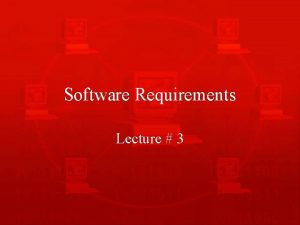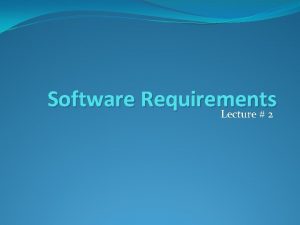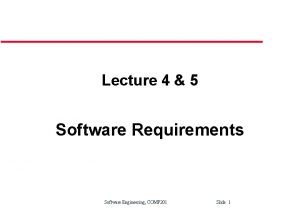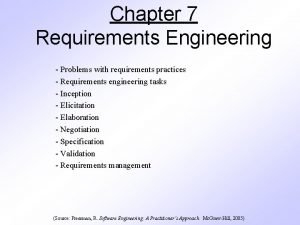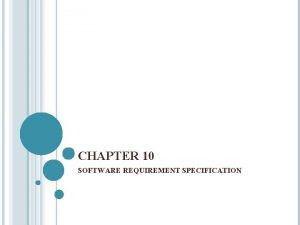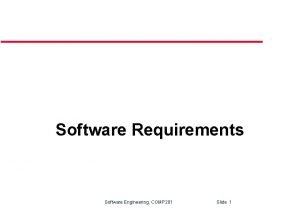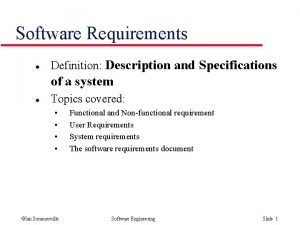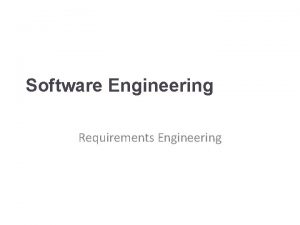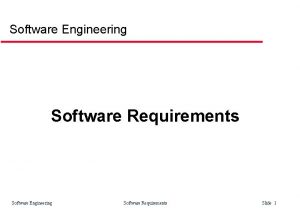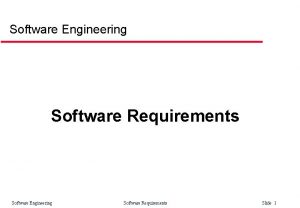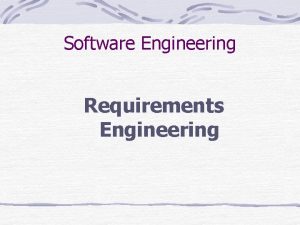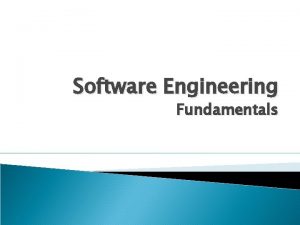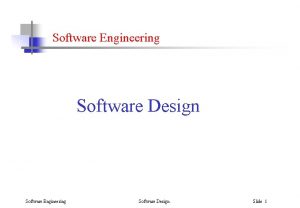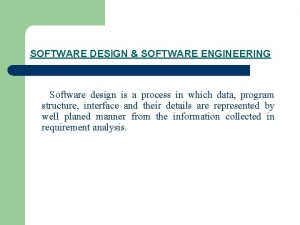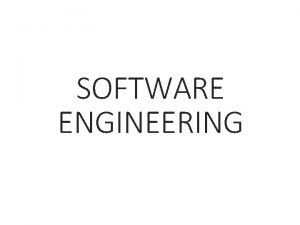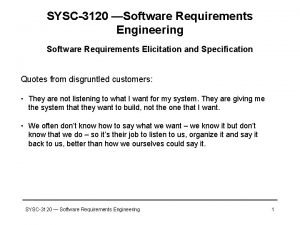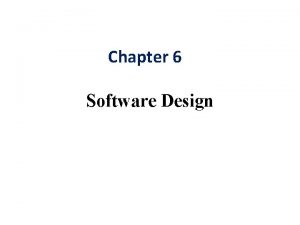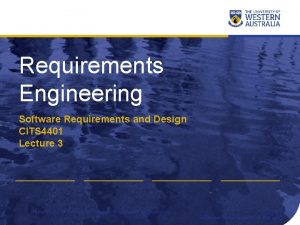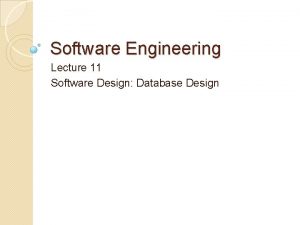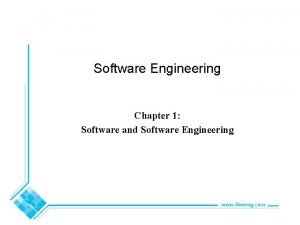Software Engineering Lecture 3 Requirements and Design Requirements






















- Slides: 22

Software Engineering Lecture 3 Requirements and Design

Requirements and design In principle, requirements should state what the system should do and the design should describe how it does this. In practice, requirements and design are inseparable 2

The Requirements Document The requirements document is the official statement of what is required of the system developers l Should include both a definition and a specification of requirements l It is NOT a design document. As far as possible, it should set of WHAT the system should do rather than HOW it should do it l 3

The IEEE Standard 1. Introduction 1. 1. Purpose 1. 2. Scope 1. 3. Definitions, acronyms 1. 4. References 1. 5. Overview 2. Overall description 2. 1. Product perspective 2. 2. Product functions 2. 3. User characteristics 4 3. Specific requirements 3. 1 User Requirements 3. 2 System Architecture 3. 3 System Requirements 4. Legal, Copyright and Other Notices 5. System Evolution 6. Supporting info. Appendix A, . .

Types of Requirements 4 Requirements set out what the system should do and define constraints on its operation and implementation 4 Functional requirements set out services the system should provide. These are mandatory for system functionality. 4 Non-functional requirements constrain the system being developed and specifies non-functional characteristics. 4 User requirements are high-level statements of what the system should do 5

The Design Document • The Requirements Document states WHAT the system should do. • The Design Document states HOW the system should do this. 6

Stages in Design Analysis Example: University Admissions System • Applicants • University administration Admissions office and Financial aid office Special offices (e. g. , athletics, development) • Computing staff Operations Software development and maintenance • Academic departments 7

Start with Requirements Step 1: Organize the requirements: • Gather a list of requirements and create a Requirements Document. Step 2: Perform design analysis: • Take the Requirements Document and perform Design Analysis in order to create the Analysis and Design Documentation. 8

Begin Design Analysis Models the requirements: Common modeling techniques are: • Procedural models • Data-centric models • Object-Oriented models • Formal models 9

Procedural Models Example - Flowchart - Operation Decision Manual operation Report 10

Flowchart Example: A University Admissions System Form received New? T Database record Notify student 11 F Update database Complete? T F Notify student Evaluate

Procedural Model Example: - Pseudo-code Example Pseudo Code: check_plan (report) if report (date_time) > due_date_time then error (too_late) if report (client) = none then error (no_client) if report (team) < min_team or > max_team then error (bad_team) if error() = none then comments = read_report (report) return (comments (text), comments (grade)) else return error() 12

Procedural Model Example: - Data-Flow Models - External entities Processing steps Data stores or sources Data flows 13

Example Data Flow Diagram: University Admissions Rejection Application Completed form Receive application Evaluate application Applicant Offer 14

Example 2: University Admissions Assemble Application Stage Acknowledgment Application form Receive Applicant Completed application Acknowledgment AND Initiate evaluation Evaluation request AND Supporting information 15 Pending database Applicant database

Example 2: University Admissions Process Completed Application Stage Rejection Evaluation request Evaluation Acceptance Special request 16 Applicant database Financial aid Offer

Requirements Analysis v. System Design • Requirements analysis should make minimal assumptions about the system design. • But the requirements definition must be consistent with computing technology and the resources available. In practice, analysis and design are interwoven. 17

Requirements & Design Scenario Planning • Create Scenarios which are descriptions of how a system is used in practice • Scenarios are helpful in requirements elicitation as people can relate to these more readily than abstract statement of what they require from a system • Scenarios are particularly useful for adding detail to an outline requirements description 18

Scenario Example: ATM System 19

Introduction to Use Cases Use-cases are a scenario based technique in UML (Unified Modelling Language) which identify the actors in an interaction and which describe the interaction itself l A set of use cases should describe all possible interactions with the system l Sequence diagrams may be used to add detail to usecases by showing the sequence of event processing in the system l 20

A Library System: Use-Cases 21

Catalogue Management: Use Cases 22
 Real time software design in software engineering
Real time software design in software engineering Software design fundamentals in software engineering
Software design fundamentals in software engineering Software engineering lecture notes
Software engineering lecture notes 01:640:244 lecture notes - lecture 15: plat, idah, farad
01:640:244 lecture notes - lecture 15: plat, idah, farad Inverse requirements
Inverse requirements Inverse requirements example
Inverse requirements example What is domain requirements in software engineering
What is domain requirements in software engineering Requirements discovery techniques in software engineering
Requirements discovery techniques in software engineering Dfd
Dfd What is domain requirements
What is domain requirements Domain requirements in software engineering
Domain requirements in software engineering Inception in requirement engineering
Inception in requirement engineering What are the characteristics of srs in software engineering
What are the characteristics of srs in software engineering User requirements software engineering
User requirements software engineering Source and sink flow
Source and sink flow Software requirements definition
Software requirements definition Software measurement and metrics in software engineering
Software measurement and metrics in software engineering Computer based system engineering in software engineering
Computer based system engineering in software engineering Forward engineering and reverse engineering
Forward engineering and reverse engineering Software maintenance process models ppt
Software maintenance process models ppt What is software implementation in software engineering
What is software implementation in software engineering Metrics computer science
Metrics computer science Types of software crisis
Types of software crisis




